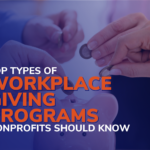What Nonprofits Need to Know About Corporate Volunteerism
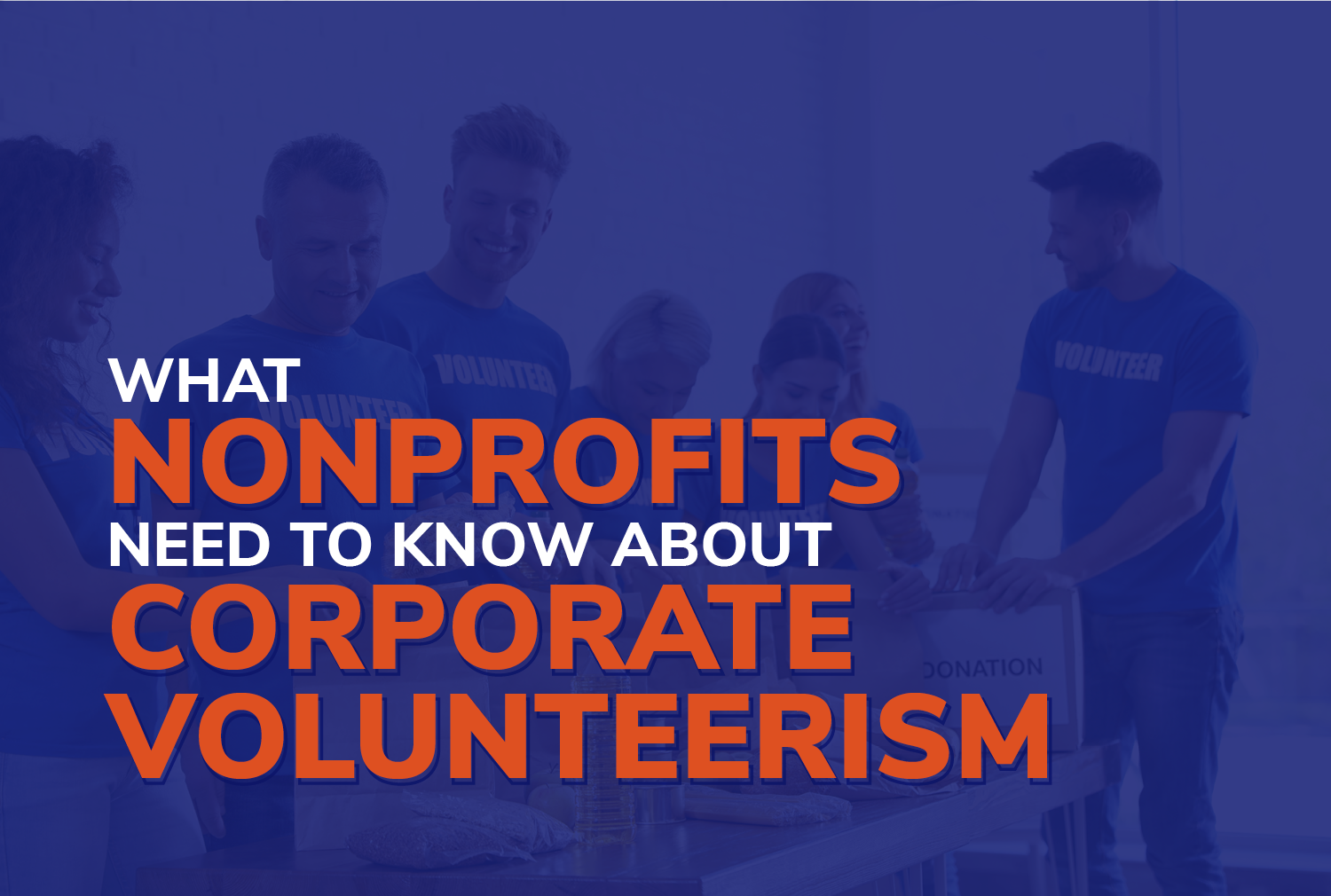
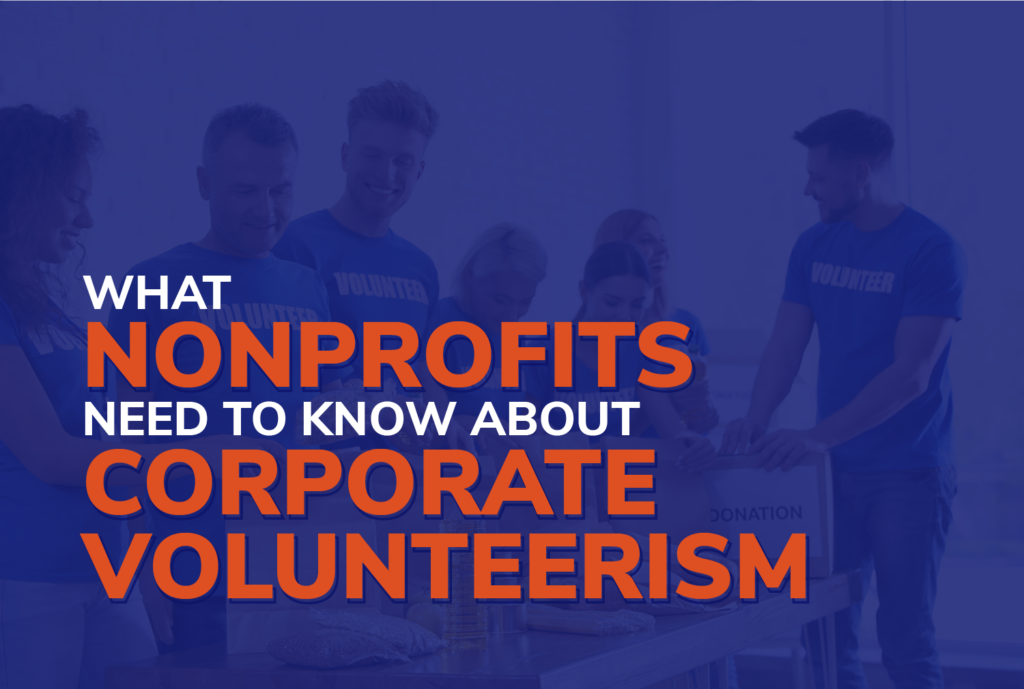
One trend in corporate philanthropy nonprofits should keep their eyes on is corporate volunteerism. Rather than offering monetary support, companies help nonprofits by encouraging their workforce to volunteer.
In this guide, we’ll explore the ins and outs of corporate volunteerism so nonprofits can take advantage of these opportunities. We’ll address:
First, let’s answer a few essential questions about what corporate volunteerism is and how it impacts nonprofits.
Corporate Volunteerism FAQ
What is corporate volunteerism?
Corporate volunteerism is a type of corporate philanthropy where companies arrange or encourage their employees to volunteer with nonprofit organizations.
Corporate volunteerism includes a wide range of programs. For example, a program that incentivizes employees to volunteer in their free time and a required volunteer outing set up by a company are both considered corporate volunteerism.
Why do companies offer corporate volunteerism programs?
Ultimately, every corporate philanthropy program is a business decision. Companies have done their research on the impact of corporate volunteerism and have found it pays off in more ways than one: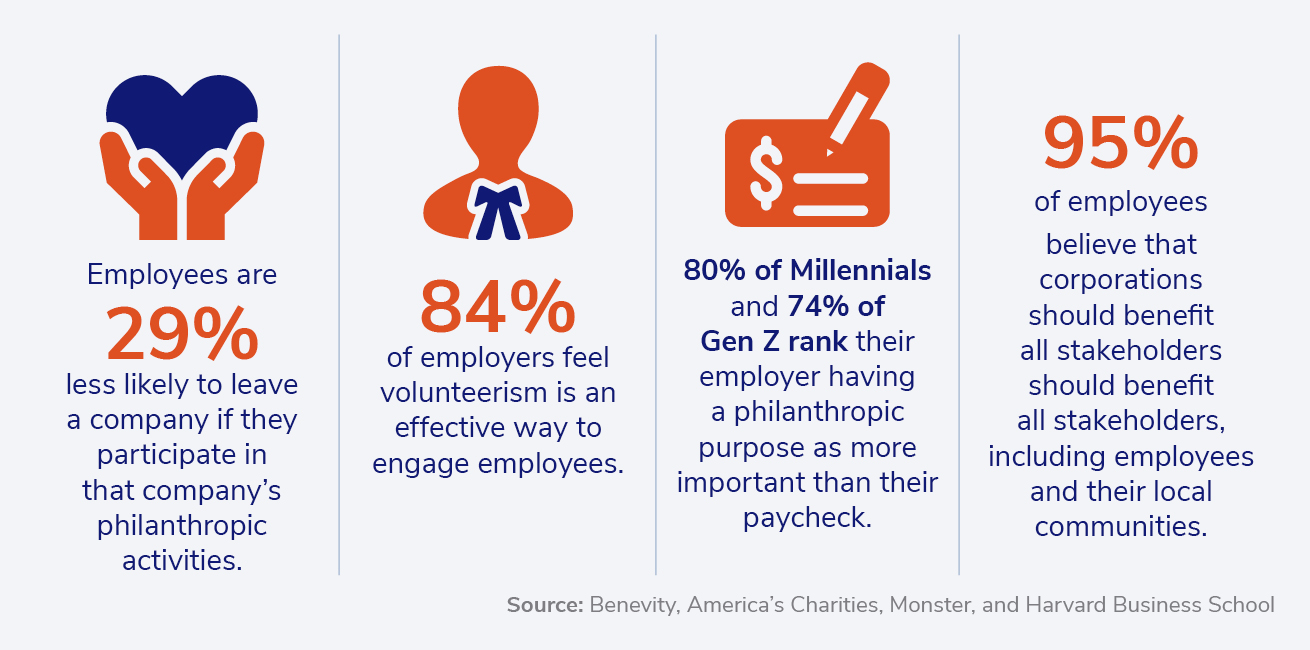
- Employees are 29% less likely to leave a company if they participate in that company’s philanthropic activities.
- 84% of employees feel volunteerism is an effective way to engage employees.
- 80% of Millennials and 74% of Gen Z rank their employer having a philanthropic purpose as more important than their paycheck.
- 95% of employees believe that corporations should benefit all stakeholders, including employees and their local communities.
This means that companies that encourage volunteerism can better engage their employees, leading to higher retention, recruitment, and productivity rates. Plus, customers who want to shop ethically are more likely to buy from brands they know launch philanthropic initiatives like volunteer programs.
How can my nonprofit get involved with corporate volunteerism?
Most often, corporate volunteer programs are initiated by businesses rather than nonprofits. However, that doesn’t mean your nonprofit can’t prompt its corporate partners to consider corporate volunteerism or launch a specific initiative to support your nonprofit.
For example, many companies use corporate social responsibility (CSR) software that highlights reputable nonprofits to their employees. Some of these platforms will even promote nonprofit volunteer opportunities. Establish your nonprofit as a trustworthy organization and reach out to these software vendors to learn how your organization can be added to their database. In most cases, this will mean filling out an application verifying your registered nonprofit status and providing details about your mission and programming.
Corporate Volunteerism Programs
Corporate volunteerism programs vary wildly, and the more familiar your nonprofit is with these various types of programs, the better you’ll be able to leverage them. Here are a few common types of corporate volunteerism initiatives:
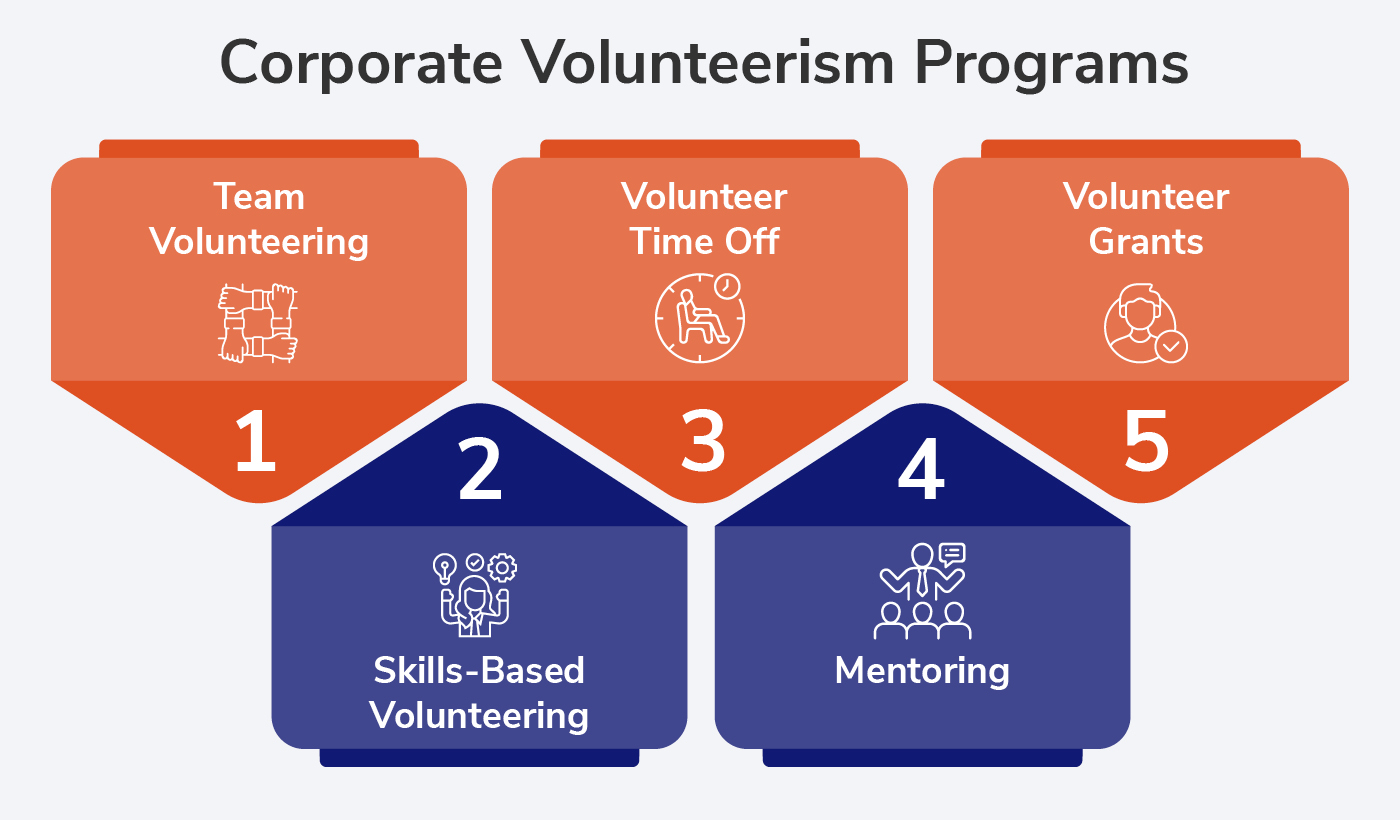
Team Volunteering
When you think of the words “corporate volunteerism,” a team of employees all working together at a nonprofit probably comes to mind. This is team volunteering, and it’s the most straightforward type of corporate volunteerism.
In team volunteering, a business arranges a day for a team of employees to volunteer at a nonprofit together. Often, these are mandatory events for employees that take place during the work day. It is also possible for passionate employees to organize a team of their co-workers to volunteer together in their off time. Although, if their company does not directly support, arrange, or incentivize it, then that would just be considered regular team volunteering rather than corporate team volunteering.
Ideally, a business will reach out to your nonprofit in advance to arrange the team volunteer opportunity. This allows your nonprofit to prepare for a large volunteer group that wants to work together. However, some nonprofits have had issues with corporate volunteer teams giving little notice before suddenly showing up with more volunteers than the nonprofit can accommodate at one time.
Ultimately, when arranged well, team volunteering is a team-building exercise for businesses and provides your nonprofit with the hands needed to advance key projects in a short period of time.
Skills-Based Volunteering
Many volunteer roles, such as sorting supplies, greeting event attendees, planting trees, and picking up trash, can be accomplished by almost anyone. While it would be wrong to call these types of positions unskilled, there are also volunteer responsibilities that require specialized skill sets, such as designing a website, translating documents, and providing pro-bono legal services.
These types of positions are called skills-based volunteering. Double the Donation’s guide on the subject shares this helpful definition that sums up this concept:
Also referred to as SBV, skills-based volunteering is a form of volunteerism in which individuals use their specialized skills and professional knowledge to assist nonprofits, community organizations, or other philanthropic causes free of charge.
Often facilitated through employee giving programs, skills-based volunteers contribute their talents and capabilities to charitable organizations to help address complex challenges, enhance organizational capacity, or advance specific projects.
Be aware that in some cases, skills-based volunteering can be considered a type of in-kind donation. In-kind donations are usually objects, such as donating clothes to a homeless shelter, but services can also be given through in-kind donations. For example, a photography studio might have a photographer photograph one of your events free of charge as an in-kind donation.
The main difference is that skills-based volunteering is seen as a mutual agreement while in-kind service donations are usually a specific service offered by a company given for free.
For example, skills-based volunteering would be a team of programmers might see that your nonprofit has open volunteer positions that list coding proficiency as a required skill and sign up for those roles. In contrast, if a technology consulting agency reached out and offered your nonprofit their website auditing package for free, that would be an in-kind donation.
This difference matters because in-kind donations of services must be reported to the IRS on your Form 990. If a business arranges a team volunteer day specifically to lend their employees’ skills to your nonprofit, be clear about whether it is skills-based volunteering or an in-kind donation of services. Businesses will also want to be clear about this since they can report the opportunity to receive a tax deduction if it’s an in-kind donation.
Volunteer Time Off
49% of individuals report that their biggest obstacle to volunteering is conflicting work commitments. Whether it’s because they are working or are too tired, many employees who would like to volunteer are unable to.
Companies have recognized this issue, and many of them have sought to rectify it by offering volunteer time off (VTO). VTO provides employees with a set amount of paid time off specifically to volunteer. This allows employees to volunteer during their regular work hours, making employees who know they have VTO available more likely to volunteer.
Mentorships
Some companies encourage employees to take on long-term volunteering commitments with mentoring. Rather than handling various volunteer responsibilities, mentorships involve employees helping a few specific beneficiaries by providing them with advice and training to improve their skills.
Mentorships can focus on life skills in general or be related to a specific career path. For example, a software development company might involve coding lessons in their mentorships while an accounting firm might provide general advice about good budgeting and investing practices.
Volunteer Grants
Companies can incentivize employees to volunteer with nonprofits through volunteer grants. When an employee who’s eligible for a grant volunteers, their company will donate to your nonprofit based on the number of hours volunteered.
Volunteer grant program structures and requirements vary widely. Almost all programs pay based on the number of hours volunteered using one of these three structures: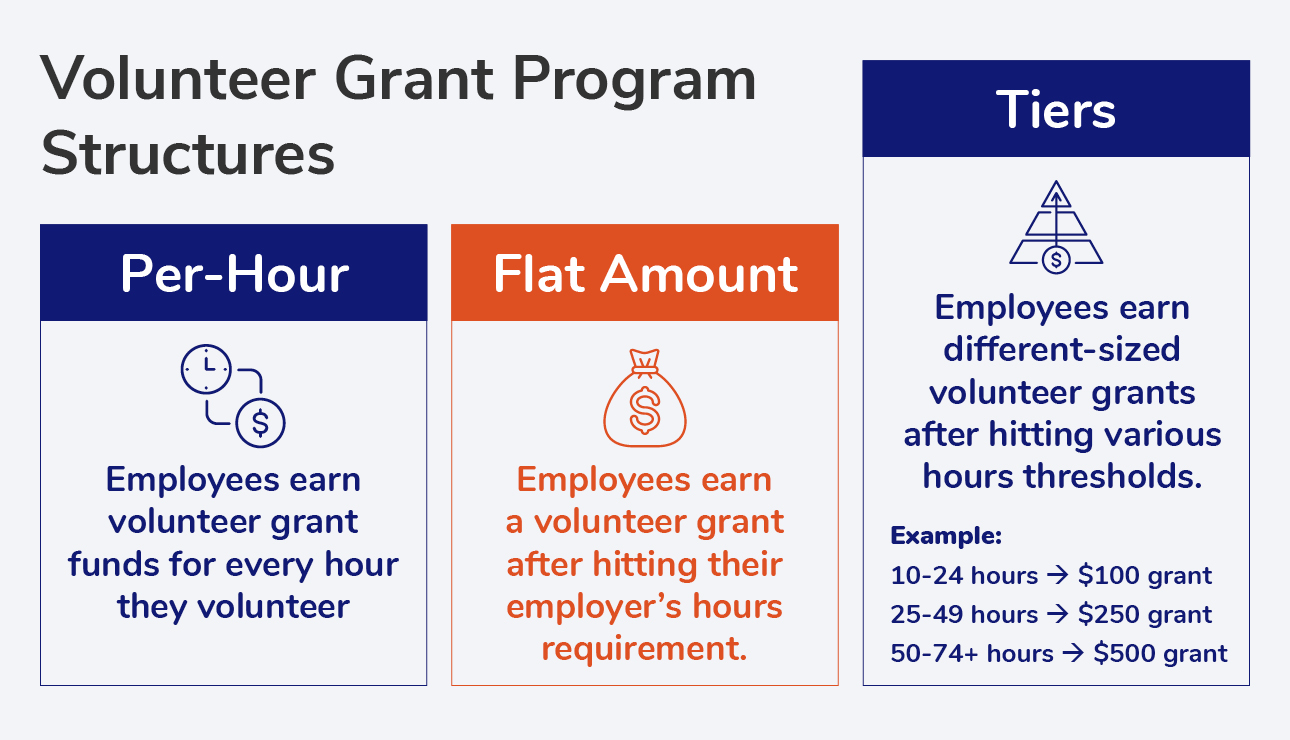
- Per-hour. Per-hour programs are usually the most generous type of volunteer grant since employees can earn donations for your organization immediately. For example, if a business donates $10 for every hour volunteered, an employee volunteer spending two hours with your nonprofit on a weekend will earn your nonprofit $20.
- Flat amount. After hitting a specific number of hours, a company will make a flat donation to your nonprofit. For example, after volunteering 50 hours, a company might donate $500. Employees just need to reach the minimum amount of hours required.
- Tiers. Tiers are the most complicated type of volunteer grant program. These programs require employees to volunteer a certain number of hours to earn a flat donation. Then, if they continue volunteering and reach the next tier, a second higher flat donation is made. An example of this is Disney’s “EARS to You” volunteer grant program which operates on the following tiers:
- 10-24 hours → $100 grant
- 25-49 hours → $250 grant
- 50-74 hours → $500 grant
- 75-149 hours → $1,000 grant
- 150+ hours → $2,000 grant
Whatever the program structure, applying for a volunteer grant usually follows the same general process across companies.
Volunteer Grant Process
You can discover if any of your volunteers are eligible for volunteer grants and help them apply for funding by walking them through the volunteer grant application process. Here’s how it works: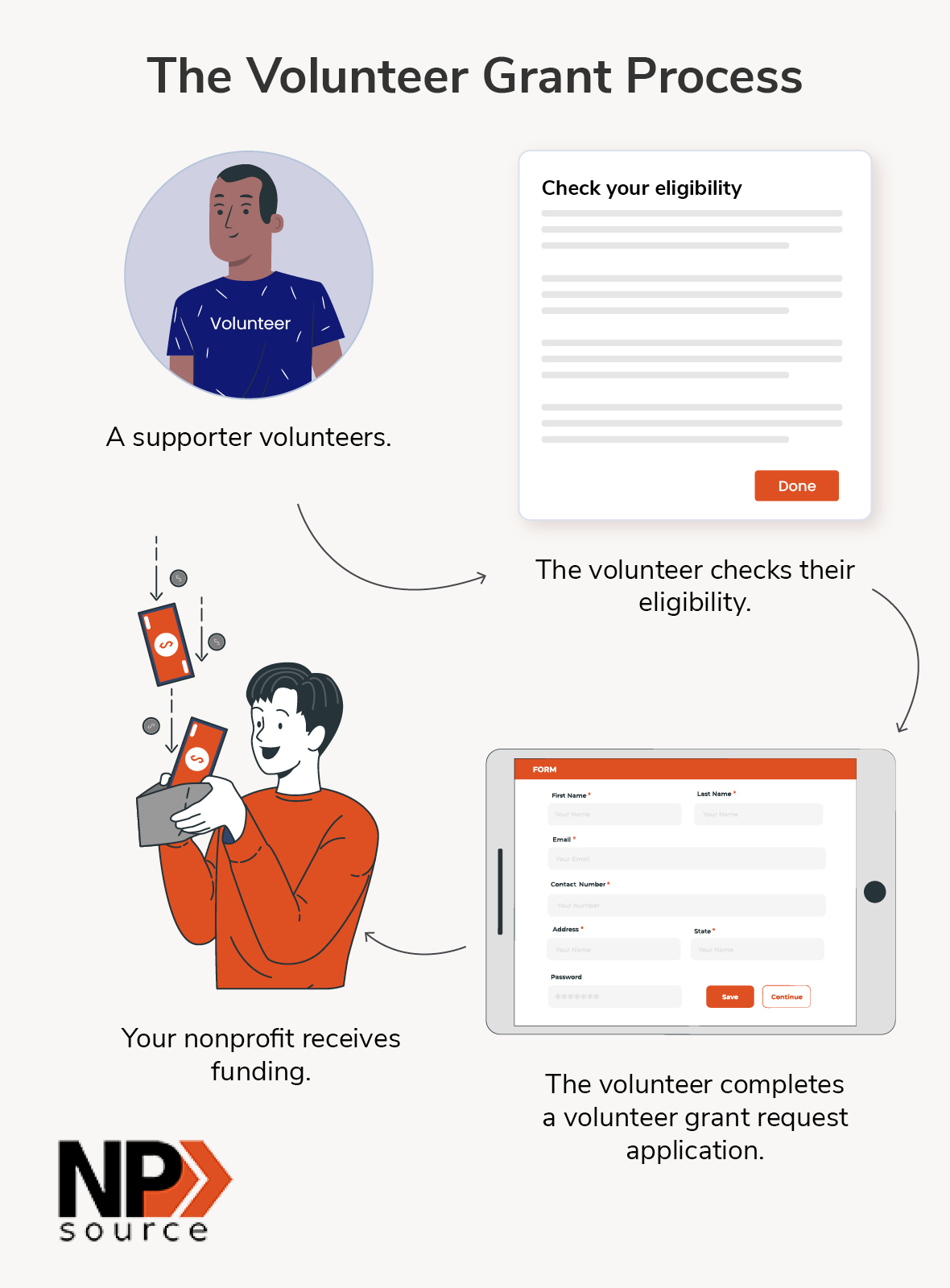
- Supporters volunteer. To qualify for a volunteer grant, supporters volunteer like they normally would. This can include volunteer opportunities they participate in of their own accord or arranged team volunteer activities.
- Volunteers check their eligibility. Volunteers can check if they are eligible for a volunteer grant by reaching out to their employer. Most employers will have relevant information about their program available in their employee CSR software portal or employee handbook. Your nonprofit can also help volunteers check their eligibility by using a volunteer grant database, which we’ll take a deeper look at soon.
- Eligible volunteers complete a grant request application. If an employee qualifies for a volunteer grant, they can request one by completing their employer’s grant application form. Usually, this form will ask for the number of hours volunteered and basic information about your nonprofit, such as how to contact you. Some businesses may reach out to your nonprofit to verify your charitable status and confirm the employees’ reported volunteer hours.
- Your nonprofit receives funding. If the grant application is approved, your nonprofit can expect to receive a donation from the company. These donations may be from the company or the company’s CSR vendor depending on their payout structure.
While any eligible volunteer can apply for a volunteer grant themselves, many will need your nonprofit’s help to learn about and follow through on these opportunities. This is where a corporate giving database comes in handy.
These databases store information about corporate giving programs, such as volunteer grants, matching gifts, and VTO. Here’s a screenshot of our recommended corporate giving database, Double the Donation Volunteering:
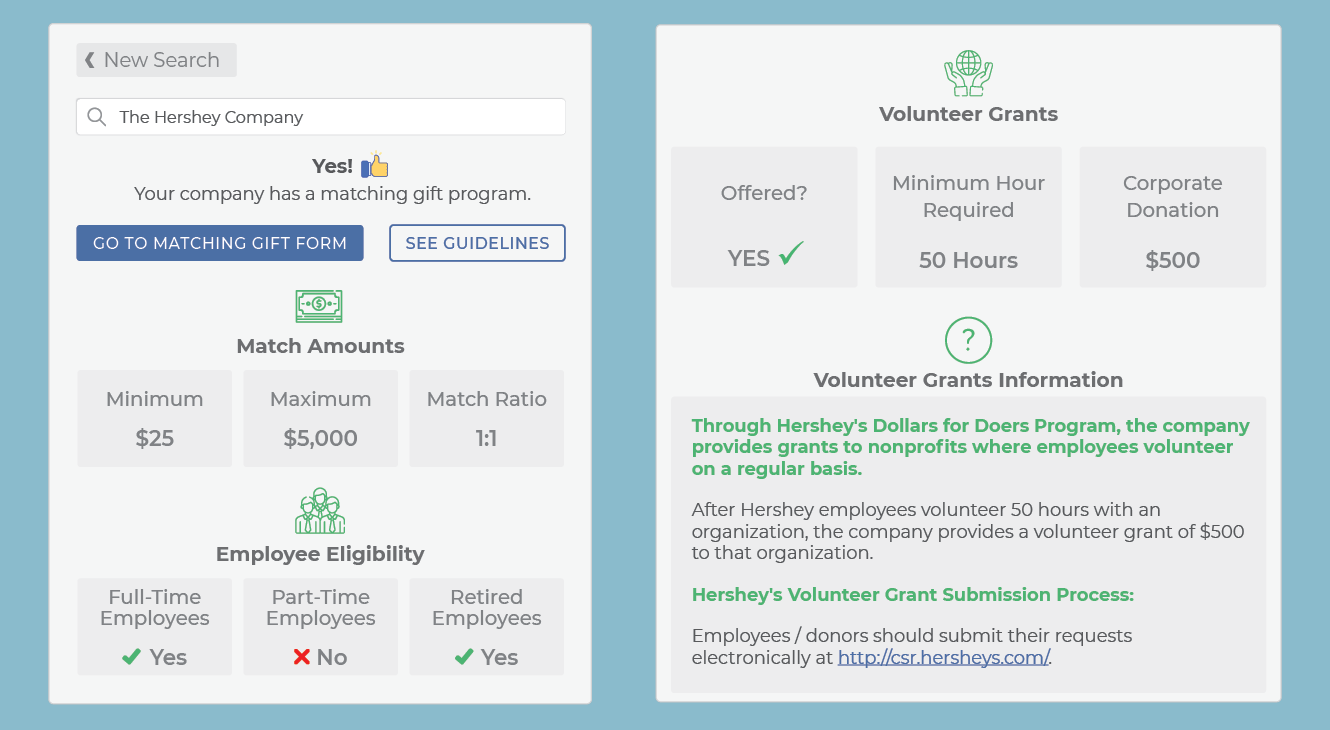 With a quick search of an employer’s name, employees can discover their employers’ requirements and application process for multiple corporate philanthropy programs. Nonprofits can embed these database search tools into their donation form or volunteer information page to encourage supporters to research their eligibility.
With a quick search of an employer’s name, employees can discover their employers’ requirements and application process for multiple corporate philanthropy programs. Nonprofits can embed these database search tools into their donation form or volunteer information page to encourage supporters to research their eligibility.
How to Prepare for Corporate Volunteers
If you’re expecting corporate volunteers, have a plan ready. This allows you to make the most of skilled volunteers and ensure team volunteering experiences are valuable for everyone involved.
Establish a point of contact.
For team volunteering events, coordinate everything with the company. Establish a point of contact who knows about or is planning the event logistics. This means if you are planning a team volunteer activity with a business you already have a corporate partnership with, you may need to loop in another point of contact.
By staying in touch with the volunteer team organizer, you’ll know when the team will arrive, how many of them there will be, and whether they have any preferences. For example, some teams may prefer for everyone to work together while others may be content with being split into smaller groups.
Use your volunteer management software to block out shifts where expect to have corporate teams. Often, corporate teams will provide more volunteers than you are used to having at one time. While it can be helpful to have a few senior volunteers around to act as supervisors and provide training, a corporate team volunteer event is not the time to onboard other new volunteers.
Have activities ready.
If you plan a team or skills-based volunteer opportunity, prepare activities that align with the business’s expectations. This can be challenging if a business tries to plan a team volunteer event last minute, so politely ask these organizers if they would be willing to push the volunteer day to a time when you will have activities ready.
When planning these opportunities, ask the organizers about their teams’ skills and preferences. Consider providing your regular volunteer job descriptions as examples of the types of tasks and skills your nonprofit needs, but also be willing to plan customized activities for specialized businesses, especially if their teams likely have skills you need.
Follow up with volunteers.
Corporate volunteers can easily become regular volunteers with the right encouragement. Here are a few ways you can retain these supporters:
- Plan additional activities. If a volunteer opportunity was arranged with a corporation, stay in touch with that business to plan future activities. You might even turn volunteering with your nonprofit into a regular annual event.
- Show appreciation. Whether a volunteer supported you on their own or was required to, thank them for their hard work. You can show appreciation by sending thank you messages, like eCards. Also, remember to thank those who pursued volunteer grants for going the extra mile to support you.
- Promote volunteer grants and VTO. Many of your supporters likely fail to take advantage of volunteer grants and VTO simply because they forget about or aren’t aware of these programs. Regularly promote these opportunities and make your volunteer grant database easily accessible.
By building relationships with corporate volunteers, your nonprofit can secure committed volunteers and strong partnerships with businesses. These might result in continued additional support, such as sponsorships.
More Volunteering Resources
Corporate volunteer programs arm your nonprofit with the funds and volunteers you need to fulfill your mission. Research corporate volunteer programs in your area and help your current supporters research their eligibility to take advantage of these free opportunities.
Corporate volunteerism is just one way businesses support nonprofits. Explore other strategies to access corporate support with these resources:
- From Cubicle to Community: How to Empower Workplace Giving. Workplace giving is another way your nonprofit can earn support from corporations. Discover types of workplace giving and how nonprofits can tap into them.
- What Is Corporate Volunteerism? The Top Guide for Companies. Interested in corporate volunteerism from a company’s perspective? Get a peek behind the curtain at the policies and decision-making that go into these programs.
- Google Ad Grants for Nonprofits: A Marketer’s Complete Guide. Get corporate support by applying for a grant that most nonprofits can earn: the Google Ad Grant. Learn how the Google Ad Grant can boost your marketing efforts and how to apply.




